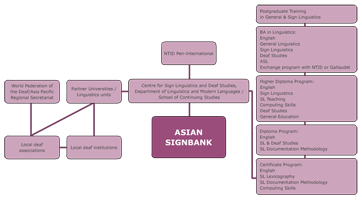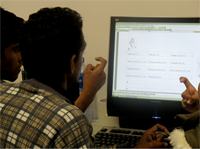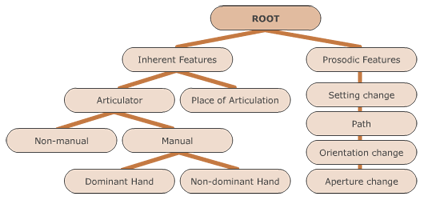|
Asian SignBank can facilitate Sign Linguistics research in the following ways:
-
Provide a platform for side-by-side viewing of signing videos and linguistics informations.
In the old days, sign language researchers had to rely on hard copies of images to analyze the linguistic features of signs. However, the movement properties cannot be represented in detail in photos. In addition, Asian SignBank is capable of storing a wide range of linguistic information of a sign. For example,
- Glosses of signs in their native language and English, to facilitate both local and international access of information,
- Individual glosses for each component in compound signs,
- Examples which make use of that sign,
- Related signs which show variation of the signs in Deaf community,
- Detailed phonetic information which includes inherent features (i.e. static features of a sign, like the handshape, place of articulation, body part, palm orientation, handparts, etc.) and prosodic features (i.e. dynamic features of a sign, like path and shape, setting, orientation, aperture and handshape changes, trilled movements, etc.)
-
Provide a querying system which helps to manipulate data into meaningful information
Other than providing a storage and viewing platform for the linguistic properties of signs, a remarkable feature of the Asian SignBank is that it allows a searching strategy of the signs according to any piece of information one may know about them, from the glosses to the most detailed phonetic information. It does not only allow searching by a feature but also by a conditioned combination of features. For instance, a user can search for a sign with handshape plus a location feature (e.g. 5-handshape + articulated on the shoulder). Virtually the system allows unlimited number of searching conditions. This searching strategy is not only used as sign retrieval purpose, but it also serves a descriptive statistical purpose such as frequency of occurrence of particular features of signs. When the system extends to include other sign languages in Asia, the system will allow a cross-linguistic comparison of signs and their linguistic information. For example, it is interesting to know how many sign languages in Asia make use of an upright Y-handshape to refer to humans, animals or animate properties in general.
|
 Welcome to Asian SignBank
Welcome to Asian SignBank
 Welcome to Asian SignBank
Welcome to Asian SignBank

 The Asian SignBank is an online database developed for sign language research. The idea, initiated by the Centre for Sign Linguistics and Deaf Studies, was realized by the joint effort of the Department of Linguistics and Modern Languages, CUHK and the Department of Systems Engineering and Engineering Management, CUHK. Tiding the efforts from two ends of research disciplines, the Asian SignBank was constructed on the philosophical ground of Sign Linguistics and assembled through the technical implementation of Systems Engineering.
The Asian SignBank is an online database developed for sign language research. The idea, initiated by the Centre for Sign Linguistics and Deaf Studies, was realized by the joint effort of the Department of Linguistics and Modern Languages, CUHK and the Department of Systems Engineering and Engineering Management, CUHK. Tiding the efforts from two ends of research disciplines, the Asian SignBank was constructed on the philosophical ground of Sign Linguistics and assembled through the technical implementation of Systems Engineering. Back to Top
Back to Top The Asian SignBank serves as a central reservoir of research data obtained in the Asia-Pacific Sign Linguistics Research and Training Program (http://www.cslds.org/apsl).
The Asian SignBank serves as a central reservoir of research data obtained in the Asia-Pacific Sign Linguistics Research and Training Program (http://www.cslds.org/apsl).
 Back to Top
Back to Top Back to Top
Back to Top




 Back to Top
Back to Top Back to Top
Back to Top
 Back to Top
Back to Top
 Back to Top
Back to Top